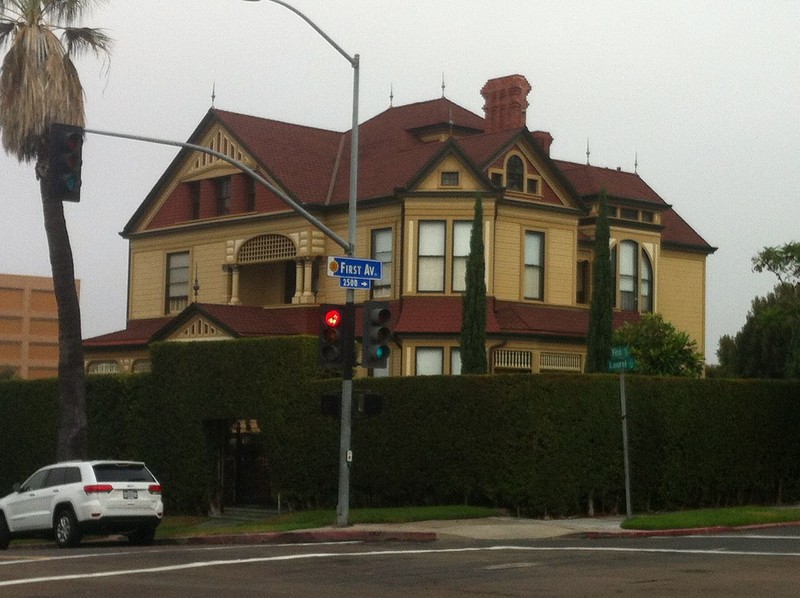Timken House
Introduction
Text-to-speech Audio
Businessman and inventor of the tapered roller bearing, Henry Timken (1831-1909), built this elegant Queen Anne house in 1888. Born in Germany, Timken invented the tapered roller bearing in 1898 for horse-drawn carriages and the next year founded the highly successful Timken Roller Bearing Axle Company, which still exists today as the Timken Company. One of Timken's daughters, Amelia, and two sisters, Anne and Amy Putnam, provided the funding to build the nearby Timken Museum of Art in Balboa Park in 1965. The house is a private residence.
Images
Henry Timken (1831-1909) built this elegant Queen-Anne style house in 1888. In 1898, Timken invented the tapered roller bearing which was a significant development in transportation history.

Backstory and Context
Text-to-speech Audio
Henry Timken was born on August 16, 1831 in a village near Bremen, Germany. The family immigrated to the United States in 1838 and on November 12th arrived in New Orleans, from which they sailed up the Mississippi River to St. Louis. Three months later, Timken's father bought land near present-day Sedalia, Missouri. The property was located next to land owned by Johann Timken, one of Timken's older siblings. Timken attended a country school near Sedalia but when he was 16 moved to St. Louis. There, he became an apprentice to a German carriage maker and three years later started working for a large carriage building company.
In 1854, Timken married his wife, Fredericka, and in 1855 founded his first carriage building company. It wasn't successful and in 1858 he moved to Belleville, Illinois and opened another carriage business with his father-in-law. Two years later, he sold his interest in the business and went to Colorado in search of gold. However, six months later he returned to St. Louis. During the Civil War, Timken served as a captain in the 13th Regiment of the Missouri Militia.
Timken's carriage-making career took a turn for the better after the war. Demand for carriages rose significantly and factories began to mass produce carriage parts. After a fire destroyed Timken's factory in 1864, he rebuilt it following the best factory design standards of the time. He built another, bigger one in 1877 that featured tall ceilings and large windows that allowed a lot of natural light to shine through. That year he also invented and patented the Timken Buggy Spring, which he marketed widely (competitors challenged his patent rights in court and ultimately the U.S. Supreme Court ruled against him but by then he had established his brand name).
Timken, apparently tired of the carriage business, decided to retire and in 1887, moved to San Diego where began to invest in real estate. He and Fredericka also started to travel around the country and Europe. His interest in carriage making never diminished, however. He closely followed the developments of the business, which was managed by his son-in-law, Appleton Bridges, who obtained three new carriage spring patents in the early 1890s. Timken came out of retirement and rejoined the company in 1892.
He began experimenting with roller bearings at this time as well and eventually developed the tapered roller bearing in 1898. This was an important development in transportation history. Until then, carriage axles generally consisted of the end of a shaft rotating in a hole, which generates a lot of friction that wears down axle components. The tapered roller bearing reduces friction significantly and increases the longevity of axle components. To demonstrate the effectiveness of the bearing, Timken allegedly installed one in a carriage with a very heavy load and instructed a driver to take it out onto the streets. The driver was arrested for animal cruelty but later in court, Timken demonstrated that the tapered roller bearing enabled the mule to pull the wagon normally despite its weight.
The Timken Roller Bearing Axle Company was very successful and in 1901 the Timken decided to move it to Canton, Ohio where an automotive industry was developing. In addition to automobiles, the company produced bearings for machine manufacturers, bicycles, building equipment, and scientific instruments. It continued to grow and produced the majority of the roller bearings in the country by 1923. Over the coming decades, the company diversified and expanded its reach globally. Timken was inducted into the National Inventors Hall of Fame in 1998.
Sources
"History of the Museum." Timken Museum of Art. Accessed August 14, 2014. https://www.timkenmuseum.org/static/media/uploads/About/collection_history.pdf.
Lubinski, Christina. "Fighting Friction: Henry Timken and the Tapered Roller Bearing." June 8, 2011. Last Updated August 22, 2018. https://www.immigrantentrepreneurship.org/entries/fighting-friction-henry-timken-and-the-tapered-roller-bearing/#_edn22.
Wikimedia Commons: https://commons.wikimedia.org/wiki/File:Timken_House_-_catercorner.JPG
